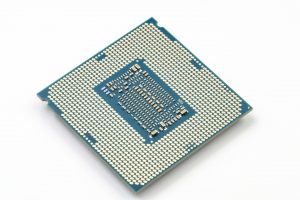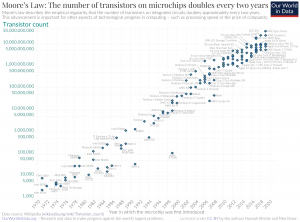3.4. Processing Data
The CPU

The core of a computer is the Central Processing Unit, or CPU. It can be thought of as the “brains” of the device. The CPU carries out the commands sent to it by the software and returns results to be acted upon. The earliest CPUs were large circuit boards with limited functionality. Today, a CPU can perform a large variety of functions. There are two primary manufacturers of CPUs for personal computers: Intel and Advanced Micro Devices (AMD).
The speed (clock time) of a CPU is measured in hertz. A hertz is defined as one cycle per second. A kilohertz (kHz) is one thousand cycles per second, a megahertz (mHz) is one million cycles per second, and a gigahertz (gHz) is one billion cycles per second. The CPU’s processing power is increasing at an amazing rate.
Besides a faster clock time, today’s CPU chips contain multiple processors. These chips, known as dual-core (two processors) or quad-core (four processors), increase the processing power of a computer by providing the capability of multiple CPUs all sharing the processing load. Intel’s Core i7 processors contain 6 cores and their Core i9 processors contain 16 cores.
Faster & Cheaper
Faster and cheaper are two words that have driven the computer industry for decades. This phenomenon of “faster, cheaper” computing is often referred to as ‘Moore’s Law’, after Intel co-founder, Gordon Moore. Moore recognized that microprocessor transistor counts had been doubling every year, enabling the development of more powerful chips to be manufactured at cheaper prices (Moore, 1965). Moore’s Law has been generalized into the concept that computing power will double every two years for the same price point. Another way of looking at this is to think that the price for the same computing power will be cut in half every two years. Moore’s Law has held true for over fifty years. (See image below).

The limits of Moore’s Law are now being reached, and circuits cannot be reduced further, but a new law, Huang’s Law has arrived. This law, named for Nvidia’s CEO Jensen Huang, says that graphics processing units (GPUs) that power artificial intelligence is increasing faster than Moore’s Law. In fact, the performance has more than doubled every year (Mims, 2020).
“Chapter 2: Hardware” from Information Systems for Business and Beyond (2019)by David Bourgeois is licensed under a Creative Commons Attribution-NonCommercial 4.0 International License, except where otherwise noted.

